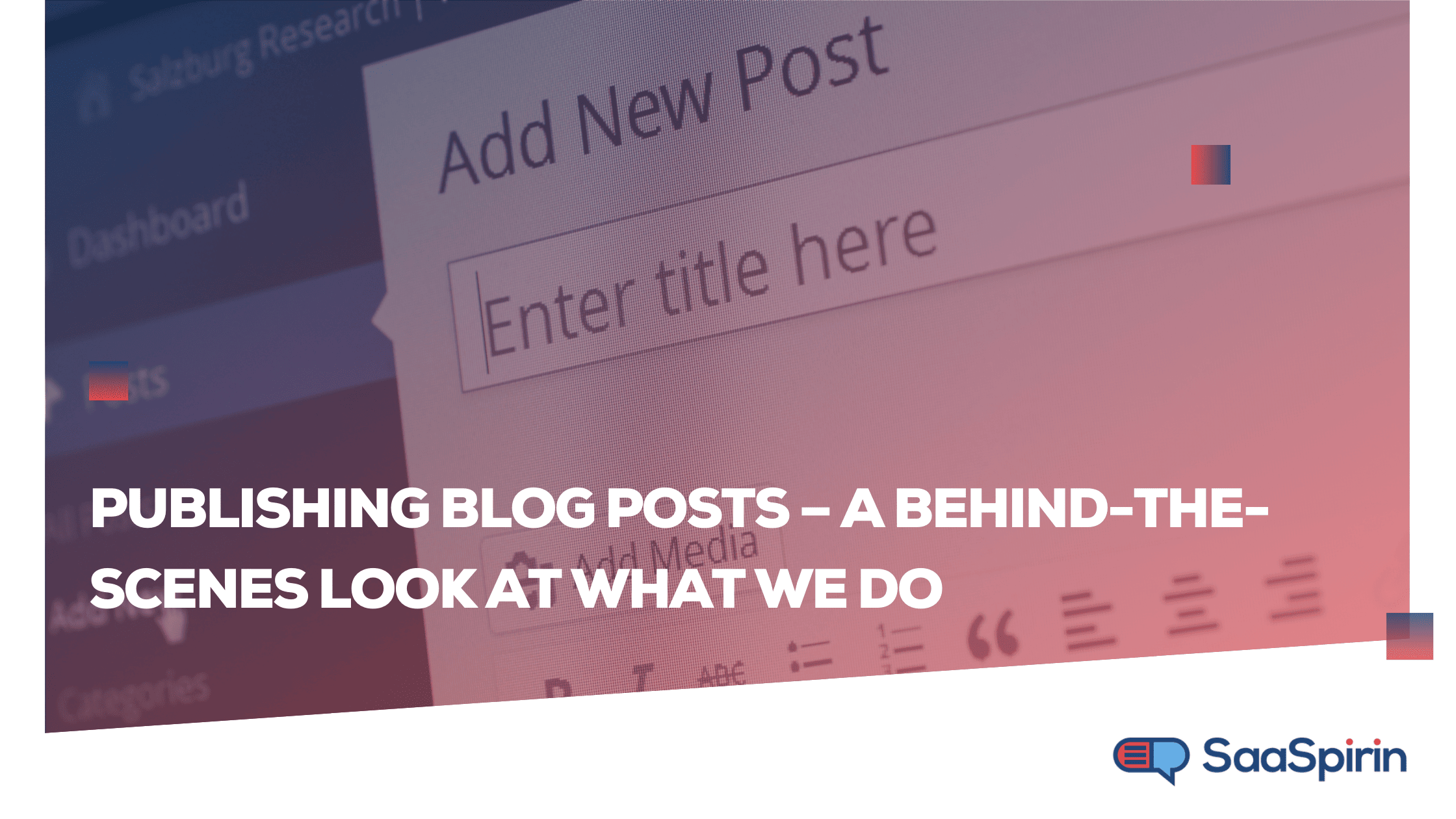Publishing Blog Posts – A Behind-the-Scenes Look at What We Do
By Nicolas Jacobeus on September 16, 2021

Each day, 4.4 million blog posts are published.
That’s some stiff competition when it comes to getting your content noticed. That’s why just having a blog isn’t enough. You have to pull out all the stops to make your blog content stand out among the rest.
One thing you can do to get a leg up is to ensure you publish every blog post the right way, every time.
Here’s a look at the process the SaaSpirin team goes through whenever we create content for clients and for our own knowledge center.
1. Pay attention to formatting
A lot goes into publishing a blog post. One of the first places we start (after receiving the writer’s draft) is to upload the blog into a content management system (CMS). After this, we use the CMS’s editor to format the blog to check that it conforms to global standards.
Proper blog post formatting ensures that our blog offers readers a positive user experience (UX). This is essential as it keeps readers on the page longer and is a significant ranking factor.
A few important things we consider when formatting include:
- The right heading tags
- Proper spacing between lines and paragraphs
- Reader-friendly fonts
A properly formatted blog post helps search engines understand what the page is about. It also makes it easier for people to read our posts.
2. Create an optimized meta description
Before we publish a blog post, we always make sure to craft an optimized meta description (the piece of text right under our headline on the search engine results pages). It describes the post and is kind of a sales pitch to entice readers to click on the post. For meta descriptions to be effective, we:
- Include our main keyword
- Make it descriptive
- Include a call-to-action
- Keep it between 120 and 165 characters
It’s that last point that makes crafting optimized meta descriptions particularly tricky. It takes excellent copywriting skills to craft meta descriptions that not only describe what our post is about but also manage to convince someone to click.
3. Include images
Images play a crucial role in blog posts. Not only do they add an aesthetic appeal, but they also help augment the message being conveyed. But when it comes to using images in blog posts, it goes beyond that. You must use the right images—and optimize them. Here are a few tips we abide by when optimizing images:
- Make sure the file size isn’t too big to ensure pages load faster.
- Include alt tags. Alt tags are short descriptions that help tell readers what the image is about if it fails to load. They also help make content more accessible.
- Use a proper image size ratio to make sure images fit in well with the text and add to the content flow.
Correctly done, images help provide a positive reader experience—and boost SEO.
4. Pay close attention to the URL
URLs play a vital role in the discoverability of blog posts. They also help users decide if a post is relevant to their search or not.
To optimize our URLs, we:
- Include our keyword
- Keep it brief
- Make it descriptive
Often your CMS will propose a default slug for your URL based on the headline, or H1, of your blog post. That may produce a good URL if your headline is clear and easy to read, includes your keyword, and is a reasonable length. Some people prefer to remove function words like "a" and "the", but many times these can paint a clearer picture of the topic for potential visitors who are deciding which page to click from search results.
5. Use a proper linking strategy
Before we publish a blog post, we always link to other posts strategically. Our linking strategy involves creating:
- Outbound links. These external links point to other reliable sources for reference. They help our readers get more information on a point we can’t fully explain in a post. Outbound links also signal to search engines that our content provides value to users.
- Internal links. These are links to other posts in our knowledge center. They keep readers on our site longer, and also help search engines crawl our content.
Having a proper linking strategy is essential to ensuring the success of our blog posts.
6. Don’t forget quality control
The final stage before we publish a blog post is always quality control. Our editors double-check a variety of things, including grammar, formatting, and linking (and anything else that stands out).
We never publish a blog until it meets or exceeds industry standards. This includes reading the post in preview mode to make sure we don’t miss anything.
Want to publish a blog? We make it easier for you
We understand how busy you are running your SaaS business. That’s why we want to take the headache out of your blog publishing process by taking care of it for you—end to end.
Sound like something you could use help with? Then get in touch today so we can show you, first-hand, the many benefits of outsourcing your blog.
You May Also Like
These Related Stories

Never Run Out of Blog Topic Ideas With This Simple Technique

4 Things You Should Be Doing to Vet Your Blog Post Ideas

